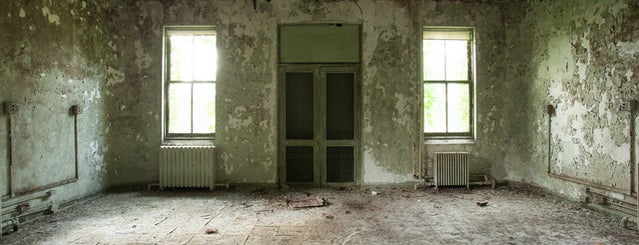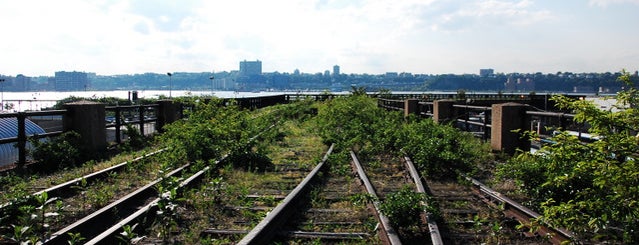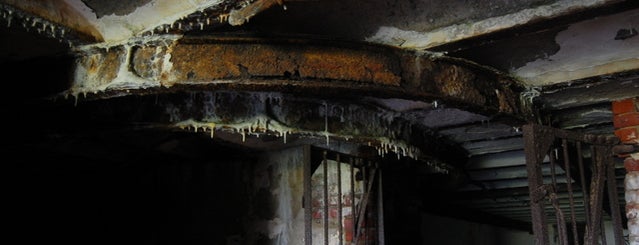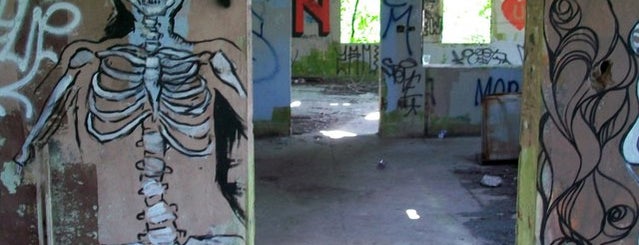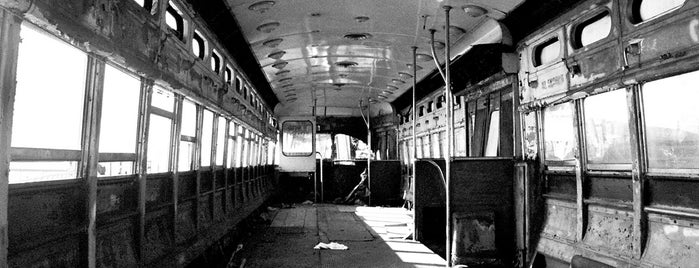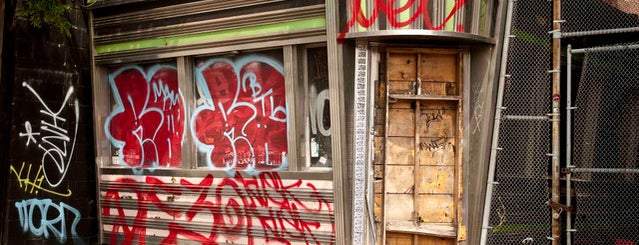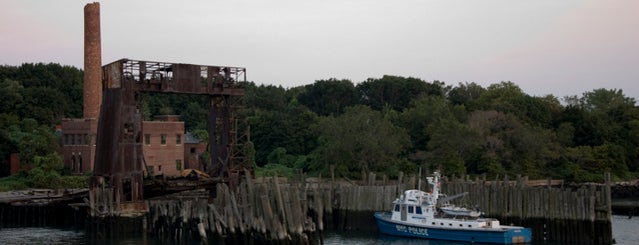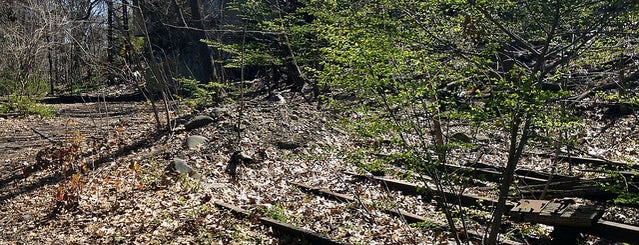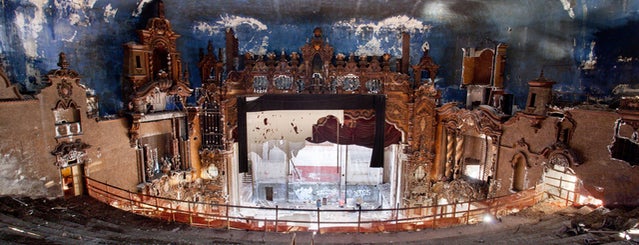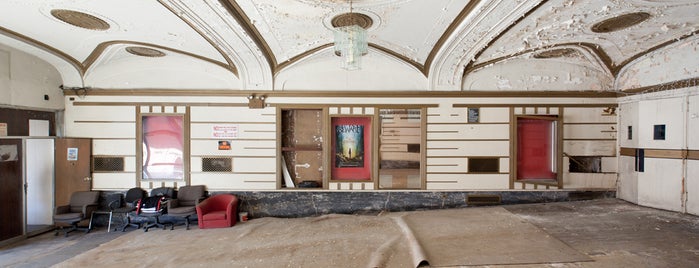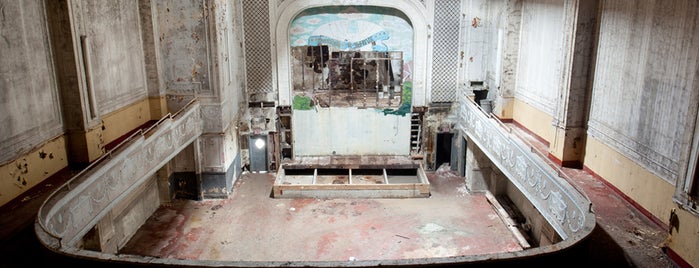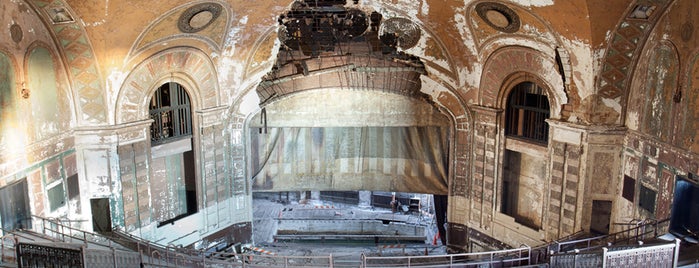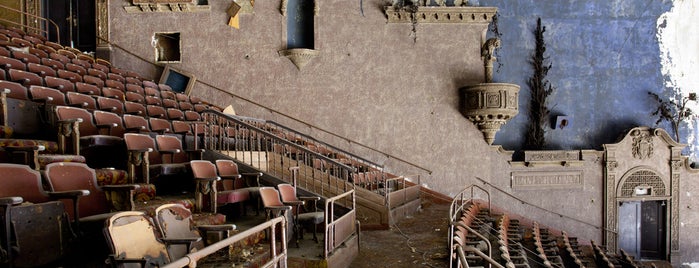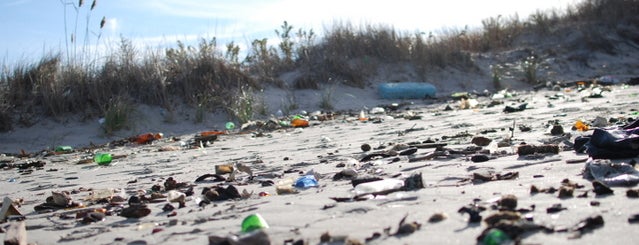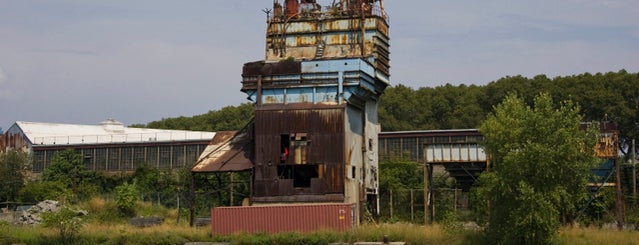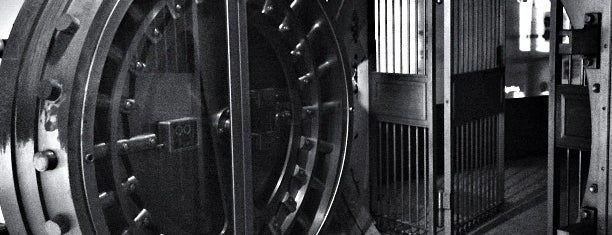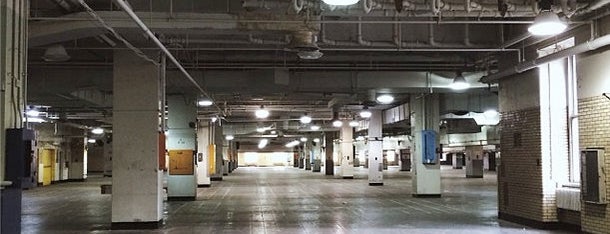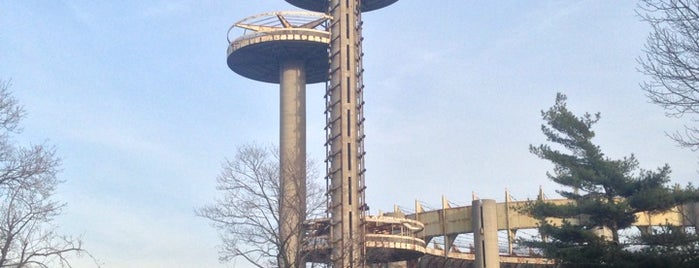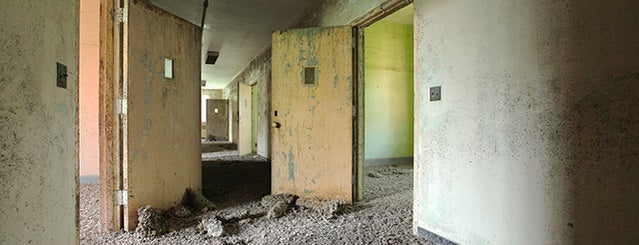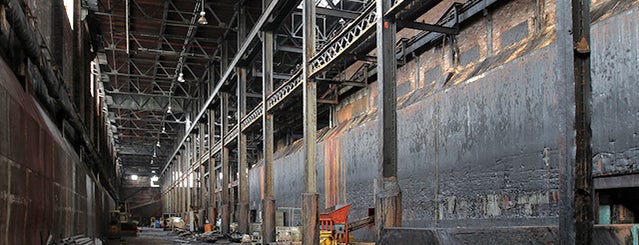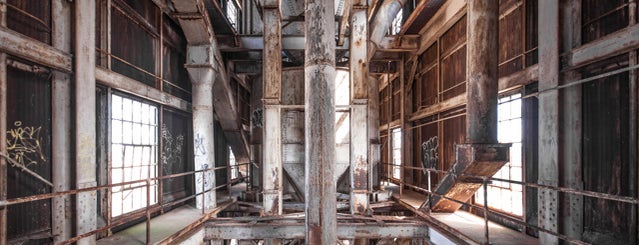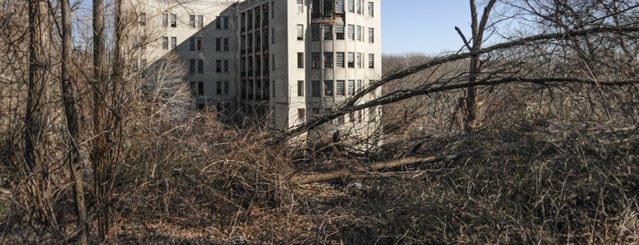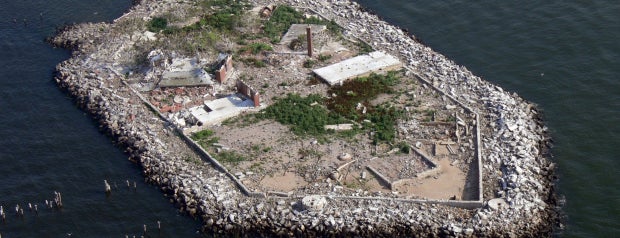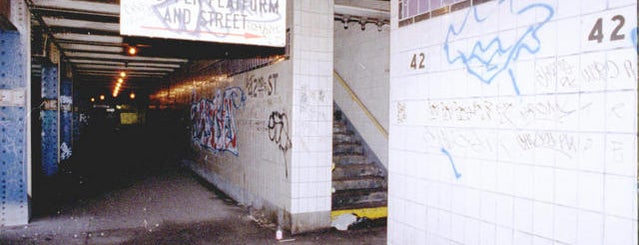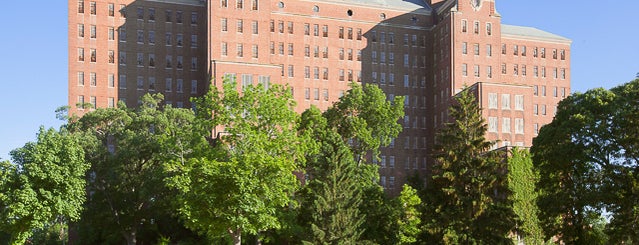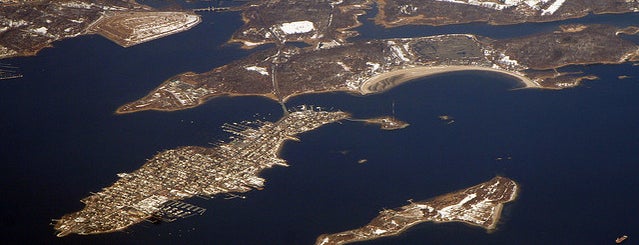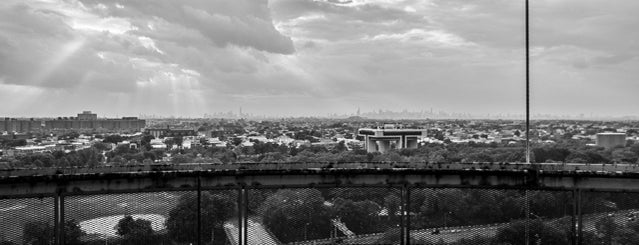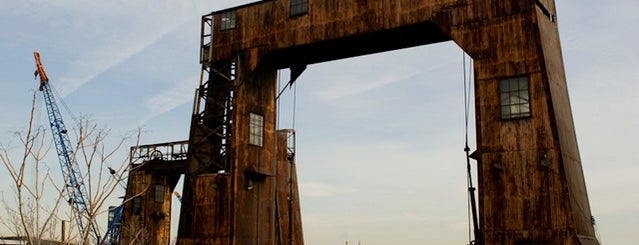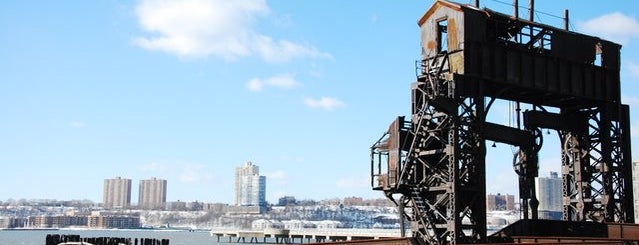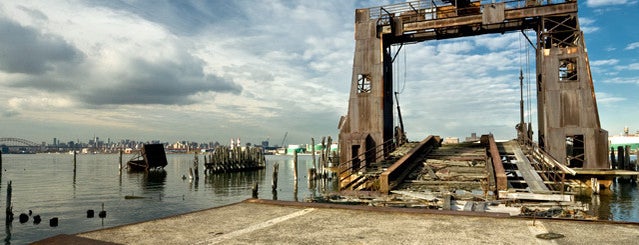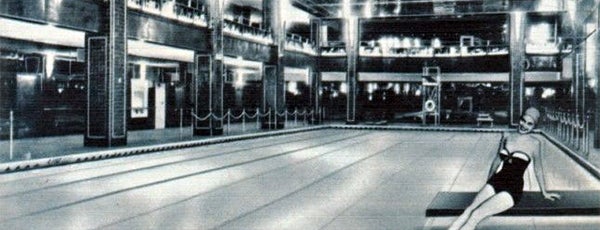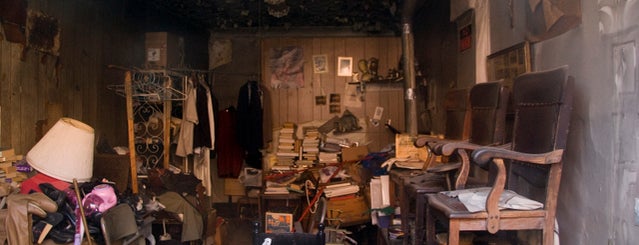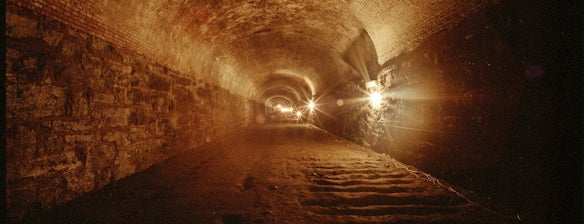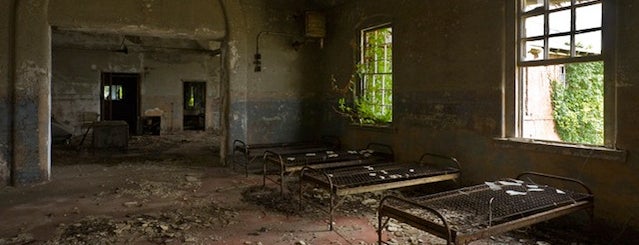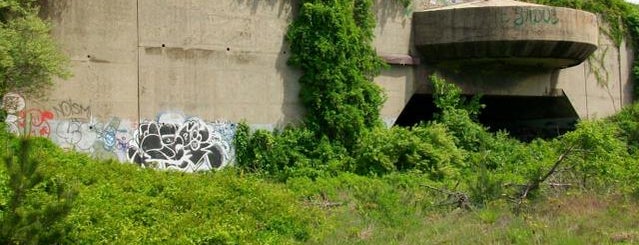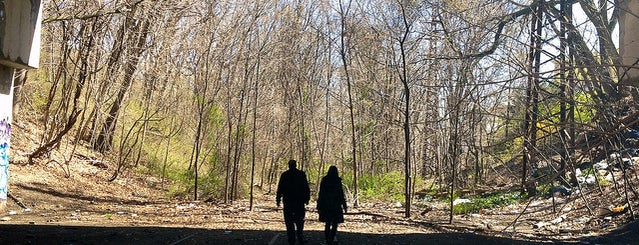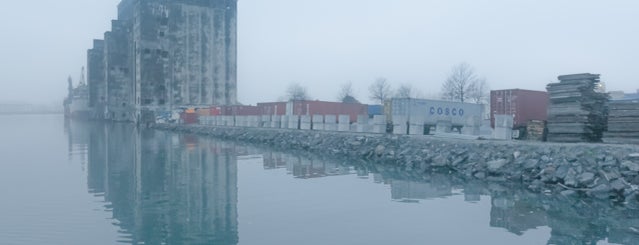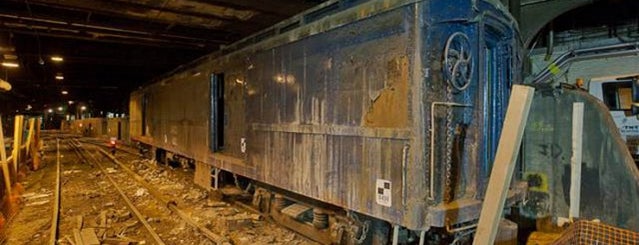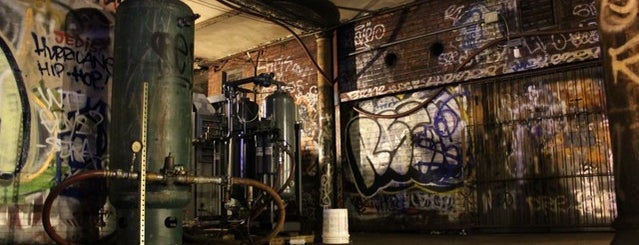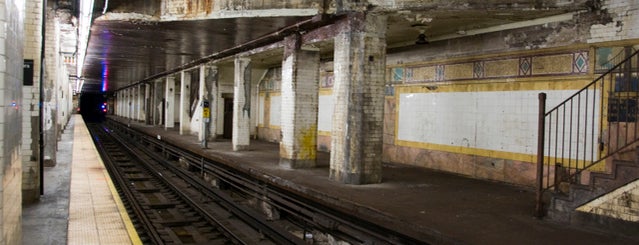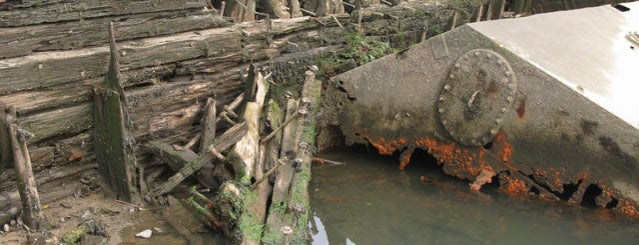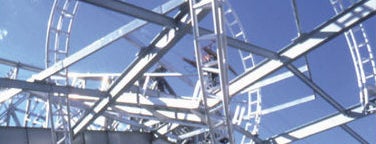![]() The intrepid explore inside the crumbling officer's quarters but also look out for what the soldiers carved into the walls of the forts. See more at: Read more.
The intrepid explore inside the crumbling officer's quarters but also look out for what the soldiers carved into the walls of the forts. See more at: Read more.
![]() One of the easiest abandoned places to break into, this enormous plant was built by the NY Central Railroad, later operated by ConEd. See photos from our expedition inside: Read more.
One of the easiest abandoned places to break into, this enormous plant was built by the NY Central Railroad, later operated by ConEd. See photos from our expedition inside: Read more.
![]() Hiding in plain sight, the abandoned South Side Hospitals were one of the largest public health undertakings in US history. See photographs of the amazing buildings at Read more.
Hiding in plain sight, the abandoned South Side Hospitals were one of the largest public health undertakings in US history. See photographs of the amazing buildings at Read more.
![]() Did you know there's still a section of the High Line that's still abandoned? We can't officially tell you how to break in but you can read about it and see photos here: Read more.
Did you know there's still a section of the High Line that's still abandoned? We can't officially tell you how to break in but you can read about it and see photos here: Read more.
![]() A beautiful decommissioned subway stop sits below the park. See it on a tour with the Transit Museum or stay on the 6 train after Brooklyn Bridge station. Find out more: Read more.
A beautiful decommissioned subway stop sits below the park. See it on a tour with the Transit Museum or stay on the 6 train after Brooklyn Bridge station. Find out more: Read more.
![]() This is the largest legal aerosol exhibit in the US, possibly the world. It was founded in '93 as a haven for aerosol artists to hone and showcase their craft. See more: Read more.
This is the largest legal aerosol exhibit in the US, possibly the world. It was founded in '93 as a haven for aerosol artists to hone and showcase their craft. See more: Read more.
![]() The abandoned hospital was designed by James Renwick and is a landmarked ruin. Help support its preservation: Read more.
The abandoned hospital was designed by James Renwick and is a landmarked ruin. Help support its preservation: Read more.
![]() In addition to surf, sand and swim, the beach is also home to a military fort dating back to 1902 that protected for New York City until World War II. See photos here: Read more.
In addition to surf, sand and swim, the beach is also home to a military fort dating back to 1902 that protected for New York City until World War II. See photos here: Read more.
![]() This formerly nuclear-armed beach protected NYC with canons, Nike, Ajax & Hercules missiles. It's now an explorer's heaven of crumbling buildings and battlements. Read more: Read more.
This formerly nuclear-armed beach protected NYC with canons, Nike, Ajax & Hercules missiles. It's now an explorer's heaven of crumbling buildings and battlements. Read more: Read more.
![]() Look for the abandoned trolleys on the pier. The cars are actually from Boston and Norway, part of an effort by one man to bring back trolleys to Brooklyn. Find out more: Read more.
Look for the abandoned trolleys on the pier. The cars are actually from Boston and Norway, part of an effort by one man to bring back trolleys to Brooklyn. Find out more: Read more.
![]() Quite possibly the smallest diner in NYC, its wedged between two buildings. Empty since 2006, the chrome and green diner is now canvased with graffiti. See more: Read more.
Quite possibly the smallest diner in NYC, its wedged between two buildings. Empty since 2006, the chrome and green diner is now canvased with graffiti. See more: Read more.
![]() Keller’s was once a hotel for sailors and later an SRO. Today all that's left is its sad state of vacancy and a retro HOTEL sign still attached. See more: Read more.
Keller’s was once a hotel for sailors and later an SRO. Today all that's left is its sad state of vacancy and a retro HOTEL sign still attached. See more: Read more.
![]() An island of rich history: a smallpox hospital in the 1850s, where Typhoid Mary died, a home to WWII veterans, and a drug center in the 1950s. It's now abandoned and off limits to the public. Read more.
An island of rich history: a smallpox hospital in the 1850s, where Typhoid Mary died, a home to WWII veterans, and a drug center in the 1950s. It's now abandoned and off limits to the public. Read more.
![]() The city’s only remaining commercial marine salvage yard. Wear good shoes and explore are your own risk. Some pictures of the amazing place: Read more.
The city’s only remaining commercial marine salvage yard. Wear good shoes and explore are your own risk. Some pictures of the amazing place: Read more.
![]() The fabled Admirals Row saw demolition in Jan '12 but you can still see the two last townhouses and crumbling manufacturing buildings. Read about what'll happen to the yards: Read more.
The fabled Admirals Row saw demolition in Jan '12 but you can still see the two last townhouses and crumbling manufacturing buildings. Read about what'll happen to the yards: Read more.
![]() Part of the abandoned QueensWay, or the "Queens High Line" is just nearby. For the intrepid, it's worth an exploration along the old train tracks. Read more.
Part of the abandoned QueensWay, or the "Queens High Line" is just nearby. For the intrepid, it's worth an exploration along the old train tracks. Read more.
![]() Castles? In New York? Why, yes! These ruins are a must, built by the Bannerman family as warehouse facility for their military surplus business in 1901. Get there by boat or kayak, tours available. Read more.
Castles? In New York? Why, yes! These ruins are a must, built by the Bannerman family as warehouse facility for their military surplus business in 1901. Get there by boat or kayak, tours available. Read more.
![]() This abandoned theatre, once one of the five “Loew’s Wonder Theaters", opened on September 7, 1929 and was designed by Rapp and Rapp and decorated by Harold W. Rambush. Read more.
This abandoned theatre, once one of the five “Loew’s Wonder Theaters", opened on September 7, 1929 and was designed by Rapp and Rapp and decorated by Harold W. Rambush. Read more.
![]() The Spanish Baroque Revival styled theater opened on Christmas Day, 1928. It's been in a state of disrepair since 1987, but plans are underway to demolish it and build a 17-story tower in its place. Read more.
The Spanish Baroque Revival styled theater opened on Christmas Day, 1928. It's been in a state of disrepair since 1987, but plans are underway to demolish it and build a 17-story tower in its place. Read more.
![]() The abandoned Ridgewood Theatre opened on December 23, 1916 and was the oldest continuous first run movie theater in the country when it closed in 2008. Read more.
The abandoned Ridgewood Theatre opened on December 23, 1916 and was the oldest continuous first run movie theater in the country when it closed in 2008. Read more.
![]() Moss and Brill’s abandoned Hamilton Theatre opened in 1913. Since it stopped screening movies in 1958, it has been used as a sports arena, disco, retail space and warehouse. Read more.
Moss and Brill’s abandoned Hamilton Theatre opened in 1913. Since it stopped screening movies in 1958, it has been used as a sports arena, disco, retail space and warehouse. Read more.
![]() At 12th St, Ave B, there's an abandoned theater called The Bijou (Charles) Theatre that was built in the fall of 1926. It is currently being demolished for a church and apartment. Read more.
At 12th St, Ave B, there's an abandoned theater called The Bijou (Charles) Theatre that was built in the fall of 1926. It is currently being demolished for a church and apartment. Read more.
![]() The nearby Shore Theatre opened as the Loew’s Coney Island Theatre on June 17, 1925 and closed in 1973, after decades of showing motion pictures, burlesque, adult films and vaudeville performances. Read more.
The nearby Shore Theatre opened as the Loew’s Coney Island Theatre on June 17, 1925 and closed in 1973, after decades of showing motion pictures, burlesque, adult films and vaudeville performances. Read more.
![]() At 4515 New Utrecht Ave, there's an abandoned Loew's 46th St Theatre, which opened in Oct 1927. Many famous people played there when it was a concert venue, such as The Bee Gees and Gladys Knight. Read more.
At 4515 New Utrecht Ave, there's an abandoned Loew's 46th St Theatre, which opened in Oct 1927. Many famous people played there when it was a concert venue, such as The Bee Gees and Gladys Knight. Read more.
![]() Having served as both land dump and horse rendering plant, this area is dotted with bottles, horse bones, abandoned boats, and vintage nicknacks including creepy toys and old hand guns. Read more.
Having served as both land dump and horse rendering plant, this area is dotted with bottles, horse bones, abandoned boats, and vintage nicknacks including creepy toys and old hand guns. Read more.
![]() When you're visiting here, don't miss the abandoned Long Island Railroad Penny Bridge Station along the creek next to Cavalry Cemetery. Read more.
When you're visiting here, don't miss the abandoned Long Island Railroad Penny Bridge Station along the creek next to Cavalry Cemetery. Read more.
![]() Don't miss the vaults and a very special shower in the basement! Find out more of the secret history on Untapped Cities Read more.
Don't miss the vaults and a very special shower in the basement! Find out more of the secret history on Untapped Cities Read more.
![]() Recently closed off for renovation, this was once home to teenage runaways living the dream in an abandoned MTA powerhouse on the shore of the notoriously toxic Gowanus Canal. Read more.
Recently closed off for renovation, this was once home to teenage runaways living the dream in an abandoned MTA powerhouse on the shore of the notoriously toxic Gowanus Canal. Read more.
![]() This post office, which once supported 16,000 workers, is now the office of less than 200 people. The building is filled with abandoned rooms and offices! Read more.
This post office, which once supported 16,000 workers, is now the office of less than 200 people. The building is filled with abandoned rooms and offices! Read more.
![]() Across the street from the cemetery, there is a small abandoned greenhouse from 1895. Check out this Victorian treasure before the restoration process begins! Read more.
Across the street from the cemetery, there is a small abandoned greenhouse from 1895. Check out this Victorian treasure before the restoration process begins! Read more.
![]() The Space Age design of the New York Pavilion was intended to inspire visitors with the promise of the future, but today it serves to firmly plant the structure in the context of the 1960s. Read more.
The Space Age design of the New York Pavilion was intended to inspire visitors with the promise of the future, but today it serves to firmly plant the structure in the context of the 1960s. Read more.
![]() Creedmoor Psychiatric Center’s Building 25 was once a haven for New York City’s mentally ill, but today it houses a much more reviled and equally misunderstood breed of New Yorkers— pigeons. Read more.
Creedmoor Psychiatric Center’s Building 25 was once a haven for New York City’s mentally ill, but today it houses a much more reviled and equally misunderstood breed of New Yorkers— pigeons. Read more.
![]() Situated in the shadow of the Williamsburg Bridge, the derelict Domino Sugar Refinery remains one of the most recognized monuments of Brooklyn’s rapidly disappearing industrial past. Read more.
Situated in the shadow of the Williamsburg Bridge, the derelict Domino Sugar Refinery remains one of the most recognized monuments of Brooklyn’s rapidly disappearing industrial past. Read more.
![]() The abandoned smallpox hospital was designed by James Renwick and is a landmarked ruin. The team behind FDR Four Freedoms Park hopes to stabilize it for a visitor’s center. Read more.
The abandoned smallpox hospital was designed by James Renwick and is a landmarked ruin. The team behind FDR Four Freedoms Park hopes to stabilize it for a visitor’s center. Read more.
![]() It’s been nearly fifty years since a freighter docked at the Red Hook Grain Terminal; now black mold overspreads its concrete silos like a mourning veil. Read more.
It’s been nearly fifty years since a freighter docked at the Red Hook Grain Terminal; now black mold overspreads its concrete silos like a mourning veil. Read more.
![]() In Brooklyn, an abandoned level below the Bergen Street station is a favorite spot for urban explorers, one of many New York City subway stations that have abandoned platforms. Read more.
In Brooklyn, an abandoned level below the Bergen Street station is a favorite spot for urban explorers, one of many New York City subway stations that have abandoned platforms. Read more.
![]() Established as a city hospital for quarantinable diseases in 1885, it became a disreputable rehab center for adolescent drug addicts prior to its abandonment in the 1960s. Read more.
Established as a city hospital for quarantinable diseases in 1885, it became a disreputable rehab center for adolescent drug addicts prior to its abandonment in the 1960s. Read more.
![]() Throughout its history, the grounds of the Staten Island Farm Colony were often associated with society’s ‘unwanted’. This farm area housed the poor, infirm, mentally ill and developmentally disabled. Read more.
Throughout its history, the grounds of the Staten Island Farm Colony were often associated with society’s ‘unwanted’. This farm area housed the poor, infirm, mentally ill and developmentally disabled. Read more.
![]() The grounds of BSH house Staten Island’s first hospital, an historic colonnaded structure built in the 1830s to serve ailing retired naval and merchant sailors. Read more.
The grounds of BSH house Staten Island’s first hospital, an historic colonnaded structure built in the 1830s to serve ailing retired naval and merchant sailors. Read more.
![]() Seaview Hospital was once the largest tuberculosis sanatorium in the country, now listed on the U.S. National Register of Historic Places and is also a U.S. Historic District and NYC landmark. Read more.
Seaview Hospital was once the largest tuberculosis sanatorium in the country, now listed on the U.S. National Register of Historic Places and is also a U.S. Historic District and NYC landmark. Read more.
![]() Hoffman and Swinburne Islands were constructed from landfill in the 1870s, and served as designated quarantine stations for arriving immigrants who were found to be suffering from contagious diseases. Read more.
Hoffman and Swinburne Islands were constructed from landfill in the 1870s, and served as designated quarantine stations for arriving immigrants who were found to be suffering from contagious diseases. Read more.
![]() It’s unclear why the the lower level of the A/C/E track was constructed, it never operated as part of the IND or IRT systems. Read more.
It’s unclear why the the lower level of the A/C/E track was constructed, it never operated as part of the IND or IRT systems. Read more.
![]() Beginning in 1885, the hospital served as the largest state-funded psychiatric ward for over a century. Most tenants were relegated to agricultural duties. This was considered a therapeutic activity. Read more.
Beginning in 1885, the hospital served as the largest state-funded psychiatric ward for over a century. Most tenants were relegated to agricultural duties. This was considered a therapeutic activity. Read more.
![]() It is no surprise then that the Chimney Sweep Islands, whose name was probably derived from the fact that they look like chimney sweep tools, have never been inhabited by humans. Read more.
It is no surprise then that the Chimney Sweep Islands, whose name was probably derived from the fact that they look like chimney sweep tools, have never been inhabited by humans. Read more.
![]() According to the NYC Parks department, “George Washington used the island as a drop-off point for messages, and the place became a haven for spies." Read more.
According to the NYC Parks department, “George Washington used the island as a drop-off point for messages, and the place became a haven for spies." Read more.
![]() Designed to accommodate the 50 million visitors of the 1964 World’s Fair, the three levels of observatories can be accessed through a stairway rising up the central column of the superstructure. Read more.
Designed to accommodate the 50 million visitors of the 1964 World’s Fair, the three levels of observatories can be accessed through a stairway rising up the central column of the superstructure. Read more.
![]() Historically they were used in relation to unloading and loading ferries to North Brother Island and North Beach in Queens, to aid the neighborhoods manufacturing sector in both goods and manpower. Read more.
Historically they were used in relation to unloading and loading ferries to North Brother Island and North Beach in Queens, to aid the neighborhoods manufacturing sector in both goods and manpower. Read more.
![]() The 69th St Transfer bridge was once a transfer terminal for the New York Central Railroad, facilitating the movement of freight from railyards to river barges known as “car floats.” Read more.
The 69th St Transfer bridge was once a transfer terminal for the New York Central Railroad, facilitating the movement of freight from railyards to river barges known as “car floats.” Read more.
![]() This gantry received shuttle service from the Port Morris Gantry, located in the southern portion of the Bronx. Read more.
This gantry received shuttle service from the Port Morris Gantry, located in the southern portion of the Bronx. Read more.
![]() The hotel St. George came to a rather tragic end, when in 1995 after much of the hotel was converted to residential housing, a massive fire broke out devastating a large portion of the structure. Read more.
The hotel St. George came to a rather tragic end, when in 1995 after much of the hotel was converted to residential housing, a massive fire broke out devastating a large portion of the structure. Read more.
![]() On Court Street in Brooklyn in the middle of 3rd and 4th Place in Carroll Gardens, is an abandoned storefront where you can still see the remnants of a shoe-shine shop from the dusty windows. Read more.
On Court Street in Brooklyn in the middle of 3rd and 4th Place in Carroll Gardens, is an abandoned storefront where you can still see the remnants of a shoe-shine shop from the dusty windows. Read more.
![]() In 1844 when the Atlantic Avenue Tunnel was built, the City of Brooklyn was not one of the five boroughs...the Cobble Hill Tunnel was meant to reduce the congestion caused by a street-level train. Read more.
In 1844 when the Atlantic Avenue Tunnel was built, the City of Brooklyn was not one of the five boroughs...the Cobble Hill Tunnel was meant to reduce the congestion caused by a street-level train. Read more.
![]() Hart Island was a center for removed citizens, often taking drug rehabilitation as an alternative for hard jail time. Read more.
Hart Island was a center for removed citizens, often taking drug rehabilitation as an alternative for hard jail time. Read more.
![]() Fort Tilden was actually predated by a blockhouse built in the Rockaways during the War of 1812, though there was no large-scale defensive installation on the peninsula until Fort Tilden’s arrival. Read more.
Fort Tilden was actually predated by a blockhouse built in the Rockaways during the War of 1812, though there was no large-scale defensive installation on the peninsula until Fort Tilden’s arrival. Read more.
![]() Part of the line was absorbed as part of the A train in 1956 and is now the southern terminus of the potential QueensWay. Another section lives on as a part of the LIRR’s Rockaway Beach branch... Read more.
Part of the line was absorbed as part of the A train in 1956 and is now the southern terminus of the potential QueensWay. Another section lives on as a part of the LIRR’s Rockaway Beach branch... Read more.
![]() Section 3 of the High Line is one of the 40 locations in this year’s Partners for Preservation, a community-based initiative by American Express and the National Trust for Historic Preservation. Read more.
Section 3 of the High Line is one of the 40 locations in this year’s Partners for Preservation, a community-based initiative by American Express and the National Trust for Historic Preservation. Read more.
![]() This now defunct facility was built in the Port of New York to invigorate the underused waterway—a state-run grain elevator in the bustling industrial waterfront of Red Hook, Brooklyn. Read more.
This now defunct facility was built in the Port of New York to invigorate the underused waterway—a state-run grain elevator in the bustling industrial waterfront of Red Hook, Brooklyn. Read more.
![]() Waldorf-Astoria has an abandoned train track under it! It was built atop one of Grand Central Terminal’s many early platform lots through a lease of air rights. Read more.
Waldorf-Astoria has an abandoned train track under it! It was built atop one of Grand Central Terminal’s many early platform lots through a lease of air rights. Read more.
![]() 96th St was in service since 1904 and was part of the first subway. But with a 200 foot platform, the station was retired in 1959 for similar reasons as the abandoned Worth Street & 18th St stations. Read more.
96th St was in service since 1904 and was part of the first subway. But with a 200 foot platform, the station was retired in 1959 for similar reasons as the abandoned Worth Street & 18th St stations. Read more.
![]() There was also a Rockaway Beach service that originated from Chamber Street from 1913 to 1917, operated by the Long Island Rail Road and Brooklyn Rapid Transit. Read more.
There was also a Rockaway Beach service that originated from Chamber Street from 1913 to 1917, operated by the Long Island Rail Road and Brooklyn Rapid Transit. Read more.
![]() Before the advent of affordable airline tickets, boats––like railroads––played a much more central role in transportation.The advent of other, faster transport methods rendered boats obsolete. Read more.
Before the advent of affordable airline tickets, boats––like railroads––played a much more central role in transportation.The advent of other, faster transport methods rendered boats obsolete. Read more.
![]() On Beach Channel Drive in the Rockaways, across from where we recently started our jet ski tour around New York City, sits an abandoned court house being taken over by the elements. Read more.
On Beach Channel Drive in the Rockaways, across from where we recently started our jet ski tour around New York City, sits an abandoned court house being taken over by the elements. Read more.
![]() Whats that roller coaster looking thing, Just under the Queensboro bridge? Turns out it’s an abandoned art installation by Alice Aycock, itself sitting atop an abandoned waste transfer station. Read more.
Whats that roller coaster looking thing, Just under the Queensboro bridge? Turns out it’s an abandoned art installation by Alice Aycock, itself sitting atop an abandoned waste transfer station. Read more.

